Movement. Coordination. Motor skills. These are all things many people take for granted. But for occupational therapists, these are challenges their patients face daily.
Two Newman University occupational therapy (OT) program alumni, Leanne Bath ‘15 and Michael Reynolds ‘01, recently helped a Wichita woman learn how to use her new prosthetic arm.
They both work as occupational therapists at Ascension Via Christi in Wichita, Kansas. With their colleague, physical therapist Trina Shockey, they worked with client Sondra Stieber off and on for the past three years as she prepared to receive her new prosthetic.
When Stieber recently received her new arm — one that some are calling “bionic” — she opted for the less natural-looking prosthetic in order to spark conversation about how advances in technology and medicine are changing lives.
One of those advancements is the use of osseointegration with prosthetics.
By definition, according to John Hopkins Medicine, osseointegration is “a surgical procedure that aims to offer better quality of life and improved function and mobility to people who have had an amputation. Surgery involves inserting a metal implant into the bone of a residual limb, which then attaches directly to a prosthesis, eliminating socket-related issues.”
The process involves inserting a metal implant directly into bone, which eventually grows into the implant. The procedure allows a prosthetic to be directly connected to the skeleton. It also allows for more control and precise movement.
Stieber traveled to New York City for the surgery and Bath accompanied her in order to access the skills and knowledge she would need to provide the best therapy care for Stieber once she returned home.
They were in New York for one week — four days of which were spent working with the team of doctors doing prosthetic training.
“The combination of osseointegration, pattern recognition software and myoelectric prosthetics is relatively new,” said Bath. “I went to New York to learn how to use the software and observe from the occupational therapist up there on her treatment techniques. It was very informative and fascinating.”
Transforming society
Reynolds, a certified hand specialist, said outpatient OT is filled with opportunities to go beyond the textbook knowledge that came with a degree. He has been known to build devices for patients to practice with in his own basement. Looking beyond developing a prosthesis, Reynolds focuses on specific patient needs and how that device will be used.
He and Bath had to figure out a way to extend Stieber’s amputated arm to allow for additional resistance.
“Her below elbow limb was so short that any strengthening to her elbow and shoulder rotators was impossible,” explained Reynolds. “Knowing our end goal, and then reverse-engineering a device that would allow us to complete this goal, helped Sondra prepare for her bionic arm. This particular device required us to use all sorts of saws, grinders and drills.”

Reynolds said creating unique and specific devices or methods for individual patients can sometimes lead to non-use if it isn’t satisfactory to the patient. Yet in Stieber’s case, he said she was “so motivated that she almost dared Leanne and I to keep tweaking things until she could use them successfully.”
Most commonly used for dental implants and joint replacement surgeries, osseointegration is making a breakthrough in the prosthetics field.
The technology behind this prosthetic can have a big impact on OT, said Bath. Because of this procedure, clients have another option to help them lead more functional and independent lives with increased ability to have more fine motor coordination needed for day-to-day activities.
Reynolds added, “It’s tough to overstate this technology and its possibilities. With our clinic being on the front end of things, hopefully, we can continue to recognize opportunities for its use and collaborate with our teams.”
Both Reynolds and Bath agree that connecting with and helping people is the first and foremost reason they became occupational therapists.
“It’s easy to identify the injury,” said Reynolds. “It’s much harder to identify the depth at which their injury has impacted them in their daily life. This insight is a unique quality that all occupational therapists possess.”
Bath said, “I love helping people and the different challenges that come with OT. It allows you to be able to think outside of the box and get creative in order to help the client achieve their goals. I don’t think you can ever be truly prepared for unpredictability in this career. The OT program at Newman is well-rounded and provides a strong general basis of what you need to know when starting out, teaching you how to be able to problem solve on your feet during a busy day.”


